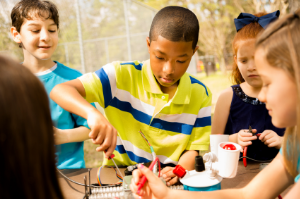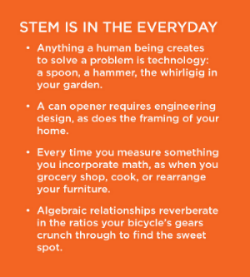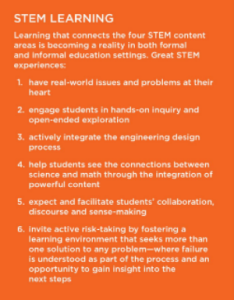
Think: Science… Technology… Engineering… Math.

While the STEM acronym stands for science, technology, engineering, and math, the real excitement comes from more than just teaching and learning academic content in those four areas, it comes from vitalizing the connections between these fields. In the best STEM programs, students are engaging in real-world problems—and solutions—creating a context for developing a deeper set of skills and new ways of thinking. STEM learning shows kids how they can make a difference, and also empowers them to make that difference.
Engage students in math and science early on—and never quit
I
Here’s where a STEM paradigm excels. STEM learning urges students to personalize their learning: tackling a problem or pursuing a line of inquiry, organizing and articulating their ideas, and sharing discoveries. Children learn how to become comfortable with taking calculated risks, exploring real-world issues, and personally investing in the outcome of their explorations.
STEM learning is among the most powerful initiatives to invigorate schools in recent years. Businesses are increasingly eager to support STEM initiatives in schools at all levels, participating in events such as STEM fairs and presentations, and, for older students, offering career-path internships. When schools collaborate with businesses, students perceive previously unimagined or unexplored career paths as real possibilities. They begin to discover that their learning can make a difference in their larger community—how powerful is that?
Whitney Cobb provides professional development and K–12 curriculum design with special expertise in STEM and cross-curricular initiatives, and is the voice behind STEM@McREL Twitter and Facebook accounts. She is McREL’s lead for NASA’s Dawn Mission education and communications team and a partner with NASA’s Discovery and New Frontiers Programs. Whitney was an assistant principal, science specialist in 1st-8th grades, and high school science teacher prior to joining McREL.


Whitney,
I support the STEM initiative wholeheartedly. I am interested in how schools are being innovated in teaching STEM and tying it in to real world scenarios.
My school is starting small by asking teachers to “engineer-ize” a current activity that we are already doing with students. In this way, you already know that the activity supports the curriculum. Teachers must think through changes to their activity that makes it more of an engineering task. Additionally, teachers may add more math, science or technology, if applicable. Many are doing this by simply adding constraints to the activity and introducing the design process. It gives teachers a great way to introduce the idea that designs will not always succeed, and that failure is useful. So often we don’t allow our students the opportunity to fail and learn from the failure to improve the process. “Failing forward” is the important take away in STEM based learning.
Thank you for sharing your perspective and highlighting the benefits to students.
I recently attended a STEM Conference. I liked the fact that STEM helps students to develop the necessary skills and knowledge needed in the real-world. In my school, teachers have to do Problem-Based Learning (PBL). Would this be similar to STEM?
My school has currently started supporting the STEM initiative. It is wonderful to see students actually engaged in their learning. As a third grade teacher, we are trying to begin the process with Project Based Learning as early as 4K. My personal children (5K, 2nd, and 3rd graders) are really excited about completing engineering projects at home and presenting them in the classroom. Thanks for sharing this information. It helped me as both an educator and parent!
I agree that the STEM initiative helps students connect in a more meaningful way to the world in which they live. This will ultimately develop those critical thinkers who will be genuinely more apt to solve problems, create, explore and live a richer life. I did not go gently into the STEM era, but now I am a vested believer that it works and much of the learning involves active participation and projects, both enjoyed by our students.